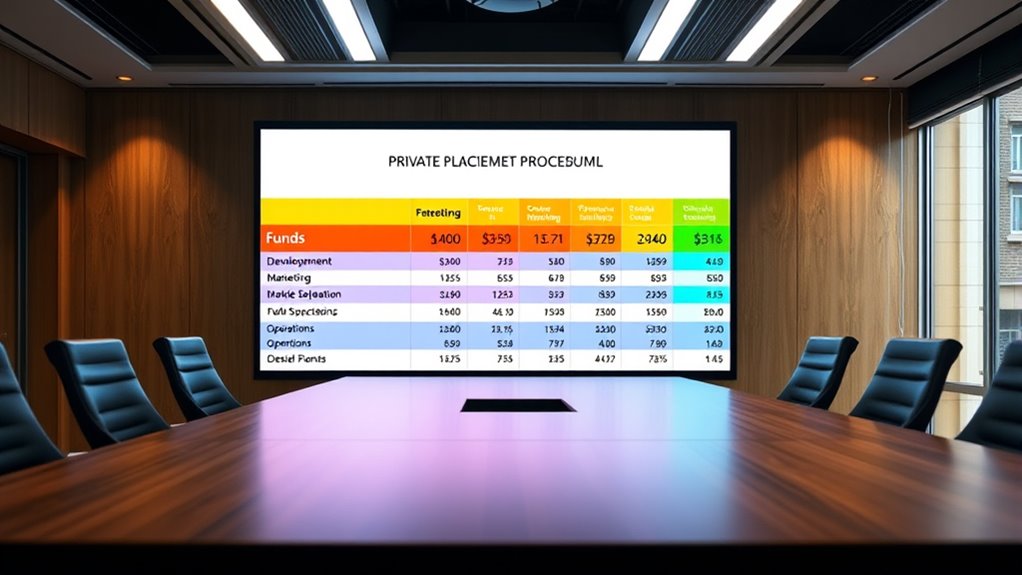You’ll find that six real-world examples of successful PPM use of proceeds tables show how clear allocation details boost investor confidence and demonstrate transparency. These examples break down costs into categories like development, marketing, and operations, often including dollar amounts and timelines for clarity. They also provide notes explaining strategic choices, making the project’s financial plan easy to follow. Keep exploring to uncover how these tables can sharpen your approach and build trust with investors.
Key Takeaways
- Many successful private placements include detailed Use of Proceeds tables to demonstrate transparency and build investor trust.
- Leading venture capital firms and startups often showcase clear funding allocations to highlight strategic priorities.
- Real estate syndications and infrastructure projects frequently present dollar-specific plans with timelines to reassure investors.
- Prominent crowdfunding campaigns utilize comprehensive tables with notes to clarify fund deployment and project milestones.
- Established companies in IPO filings or bond offerings use detailed tables to differentiate themselves through transparency and responsible management.

A well-structured Use of Proceeds table in a Private Placement Memorandum (PPM) can considerably enhance transparency and investor confidence. When you clearly outline how funds will be allocated, you demonstrate a commitment to investment transparency, which reassures potential investors about the project’s integrity. It’s not just about listing numbers; it’s about telling a compelling story of responsible fund management. This transparency fosters trust, encouraging investors to commit their capital because they understand exactly where their money is going and how it will be used.
In real-world successful PPMs, the Use of Proceeds table serves as a crucial communication tool. It simplifies complex financial plans into an accessible format, making it easier for investors to grasp the project’s scope and priorities. For example, a company might allocate 40% of the funds to product development, 30% to marketing, and 20% to operational expenses, with the remaining 10% reserved for contingencies. Clear categories like these help investors see the strategic focus behind the funding, promoting open investor communication. When investors understand the rationale behind each allocation, they’re more likely to view the project as well-managed and credible, which can lead to increased confidence and a higher likelihood of funding.
A clear Use of Proceeds table enhances investor understanding and confidence by outlining funding priorities and strategic focus.
Successful PPMs also showcase transparency by including specific dollar amounts and timelines for each expenditure. Instead of vague descriptions, detailed figures demonstrate that the company has thoughtfully planned its financial needs. This level of detail reassures investors that the entrepreneur has considered all aspects of funding and is prepared to execute accordingly. It’s about building a narrative of accountability, where each dollar has a defined purpose, reducing uncertainty and perceived risk.
Moreover, in these well-crafted tables, you often find notes or explanations that clarify the reasoning behind each allocation. This additional context improves investor communication, making it easier for investors to evaluate the project’s feasibility and strategic priorities. By openly discussing how funds will be used, you convey professionalism and transparency, which are essential for establishing long-term investor relationships. Additionally, understanding the importance of high-quality data in financial planning can help reinforce the accuracy and credibility of your projections.
Ultimately, a successful Use of Proceeds table isn’t just a financial document; it’s an essential communication bridge. It confirms your commitment to transparency and helps build trust with investors. When your table is clear, detailed, and honest, you profoundly improve your chances of securing funding and fostering ongoing investor support. In the end, effective use of this table can differentiate your offering, making it more appealing in a competitive investment landscape.
Frequently Asked Questions
How Do PPM Tables Differ Across Industries?
You’ll notice that PPM tables differ across industries because of industry-specific disclosures and sectoral funding patterns. For example, tech companies focus on product development, while energy firms emphasize infrastructure. These differences shape how proceeds are allocated and disclosed, reflecting sector priorities. Understanding these variations helps you assess each industry’s unique funding strategies and transparency levels, ensuring you grasp the nuances behind each PPM table’s structure and focus.
What Are Common Mistakes in Creating Proceeds Tables?
When creating proceeds tables, you might overlook proceeds transparency and investor clarity, which are vital. Common mistakes include vague descriptions of fund allocations, inconsistent data, or omitting specific timelines. These errors can confuse investors and reduce trust. To avoid this, make sure your proceeds tables are detailed, accurate, and easy to understand, providing clear insights into how funds will be used. This helps foster transparency and builds investor confidence.
How Do Investors Verify Proceeds Allocations?
When verifying proceeds allocations, you should review the detailed funds allocation section carefully, guaranteeing it aligns with the company’s disclosures and business plan. Confirm that the investor verification process involves cross-checking with official documents like the PPM, financial statements, and third-party audits if available. By doing this, you can ensure the funds allocation is transparent, accurate, and trustworthy, giving you confidence in the investment’s proper use of proceeds.
What Legal Considerations Impact Proceeds Table Disclosures?
When considering proceeds table disclosures, you need to guarantee compliance with regulatory requirements, which mandate clear and accurate disclosures to protect investors. You must also adhere to disclosure requirements that prevent misleading information. Failing to meet these legal considerations can lead to penalties or legal disputes. Stay updated on relevant securities laws and ensure your proceeds table accurately reflects the intended use of funds, fostering transparency and trust with investors.
How Often Should Proceeds Tables Be Updated Post-Issuance?
Ever wondered how often you should do post-issuance updates for proceeds tracking? Typically, you should update proceeds tables regularly, such as quarterly or semi-annually, to guarantee accuracy. Frequent updates help maintain transparency and compliance with legal standards. Staying current allows investors to see how proceeds are used over time, which builds trust. So, set a schedule that aligns with your reporting obligations and operational changes to keep everyone informed.
Conclusion
Think of a PPM use of proceeds table as your company’s roadmap—guiding investors through your journey’s destination. When crafted well, it illuminates your path forward, building trust and confidence along the way. By learning from these real-world examples, you can navigate the complexities with clarity and purpose. Remember, a clear and transparent table isn’t just a formality; it’s the compass that points investors straight to your success story.









